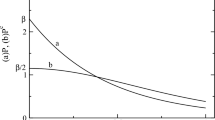Abstract
—We apply a stacking method to investigate the time distribution of foreshock activity immediately before a mainshock. The foreshocks are searched for events with M≥ 3.0 within a distance of 50 km and two days from each mainshock with M≥ 5.0, in the JMA catalog from 1977 through 1997/9/30. About 33% of M≥ 5.0 earthquakes are preceded by foreshocks, and 50–70% in some areas. The relative location and time of three types of representative foreshocks, that is, the largest one, the nearest one to the mainshock in distance, and the nearest one in time, are stacked in reference to each mainshock. The statistical test for stacked time distribution of foreshocks within 30km from and two days before mainshocks shows that the inverse power-law type of a probability density time function is a significantly better fit than the exponential one for all three types of representative foreshocks. Two explanations possibly interpret the results. One is that foreshocks occur as a result of a stress change in the region, and the other one is that a foreshock is the cause of a stress change in the region and it triggers a mainshock. The second explanation is compatible with the relationship between a mainshock and aftershocks, when an aftershock happens to become larger than the mainshock. However the values of exponent of the power law obtained for stacked foreshocks are significantly smaller than those for similarly stacked aftershocks. Therefore the foreshock–mainshock relation should not be explained as a normal aftershock activity. Probably an increase of stress during foreshock activity results in apparently smaller values of the exponent, if the second explanation is the case.
Similar content being viewed by others
Author information
Authors and Affiliations
Additional information
Received October 1998, revised January 16, 1999, accepted January 22, 1999
Rights and permissions
About this article
Cite this article
Maeda, K. Time Distribution of Immediate Foreshocks Obtained by a Stacking Method. Pure appl. geophys. 155, 381–394 (1999). https://doi.org/10.1007/s000240050270
Published:
Issue Date:
DOI: https://doi.org/10.1007/s000240050270




